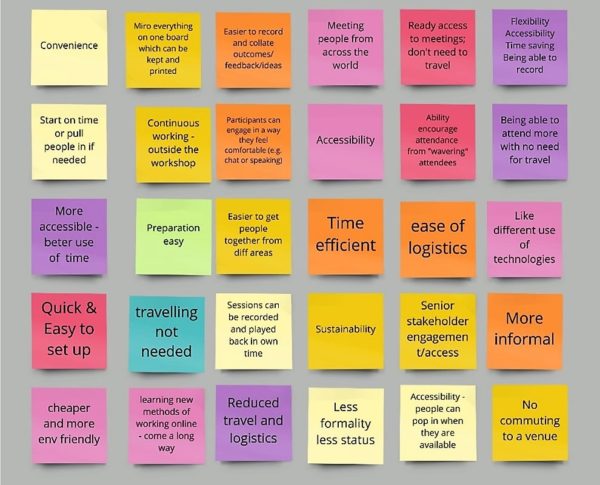
| Date | Author |
|---|---|
| 10th May 2021 | Fola Ikpehai |
Following on from a post from SUMS Group Managing Director Joel Arber on post-pandemic ways of working, we’re now exploring some of the practical challenges so often raised when considering how to deliver meaningful and effective workshops online. Today’s post from SUMS Principal Consultant Fola Ikpehai provides ‘how-to’ guidance for delivering engaging workshops and outlines the approach and key enablers that staff will need to consider to deliver a fit-for-purpose experience.
Meeting together in groups to discuss both strategic and operational challenges and activities is important for any team – this was brought into sharp focus as teams have met to discuss response and recovery plans and the return to a new normal throughout the pandemic. A well-facilitated workshop can leave staff members feeling empowered and like they have a valued voice in a discussion. A poorly delivered workshop can come across as tokenistic leaving staff feeling disengaged, undervalued and frustrated. A workshop is defined as “an interactive session where participants engage in discussion and various activities to achieve a specific purpose”. We can use workshops for problem-solving, development of specific outputs, or as a mechanism for engagement and involvement to influence decision-making.
In April, I ran two short online training sessions focused on ‘delivering effective and engaging virtual workshops’ (and yes, I do appreciate the irony!). At these sessions, delegates began to reflect on the place that online workshops would have in the post-pandemic environment. Would they totally disappear? Would they evolve or remain the same? And what about the “hybrid” approach? Let’s take these questions one at a time.
Do online workshops have a place in a post-pandemic environment?
I would suggest that the answer is yes. We are talking about ways of working in the post-pandemic environment because it is clear that post-pandemic business as usual is going to be very different from pre-pandemic business as usual. This means not throwing away everything that we have learned over the last 12 months.
What we have learnt from running virtual workshops over the last year is that we really need to be clear on:
- How we will achieve the outputs required
- The level of preparatory work required to ensure that delegates are familiar with the online tools (building practice into the start of workshop sessions)
- The use of presentations – noting that these should be short, sharp and focused because during presentations you lose what little contact you have with the delegates
- The use of chat, polling and screen time (as well as other functionality) to ensure full engagement
- The use of appropriate ice-breakers, team builders and energisers that make creative use of breakout group functionality; encourage movement, including moving away from the screen; and avoid individual/silent activity.
And finally – and perhaps most importantly – we need to be clear about how we are going to maintain high energy levels, and keep the sessions creative and lively for the duration of the workshop.
Of course, as restrictions are lifted, there will be more of a mix and match approach, with some workshops run face-to-face, and others run online. But online workshops are here to stay as an option, especially when we consider benefits like reduced travel and the absence of geographical limitations.
Will the approach to online workshops remain the same or evolve?
As we have been running online workshops over the last year, we have been getting more effective at engaging the senses and more proficient in the use of available tools. The tools themselves are also getting more sophisticated. There is a range of collaborative whiteboards, polling and word cloud functionality – all of which enhance the virtual workshop experience. Our approach will evolve as developers continue to improve the features and functionality of these tools. But the main change as we move into business as usual has to be the concept of “the hybrid”.
What does “hybrid” mean for workshops?
While my virtual workshop training sessions were focused on online delivery, it was impossible to have this discussion without delegates reflecting on what a hybrid approach would look like. So, for this scenario, we will consider two groups:
Group A – delegates based in the office environment on campus
Group B – delegates working remotely
Here are the issues that need to be considered:
The workshop environment
To run a hybrid workshop, delegates in Group A must be able to see and hear delegates in Group B – and vice versa.
- The first point to note is that delegates in Group A will require a dedicated workshop space – a meeting room where they can be together away from their work desks (just as they would in a regular workshop)
- Delegates in Group B, need to have a presence in the workshop environment. This requires appropriate audio-visual equipment in the room – a large plasma screen and speaker so that remote delegates can be seen and heard.
- Microphones and cameras (directed at the facilitator and delegates) are required in the workshop space to ensure that remote delegates can see and hear delegates in Group A.
Facilitation
Good facilitation is critical to ensure a good experience and successful outputs from any workshop. For a hybrid, this is likely to mean two facilitators – one in the physical environment (with Group A) and a co-host in the video conferencing environment. The co-host will be focused on monitoring the online chat, and coordinating the input of Group B delegates to ensure that their voices are heard.
Breakout groups
Breakout groups are a key feature of interactive workshops, and an interesting area to debate for the hybrid scenario. Would it be better to have breakout groups of Group A delegates and breakout groups made up of Group B delegates? Or – and perhaps more complicated – breakout groups with a mix of delegates from Group A and Group B? Of course, the latter would require members of Group A to enter the video conferencing workshop ‘environment’. This leads us to the discussion of tools.
Tools for hybrid workshops
In considering the tools used for hybrid workshops, I would like to pick up on a phrase used by one of the delegates at our recent session: “the remote-first (or digital-first) approach”. A remote- or digital-first approach implies full use of online tools to engage delegates and enable interactive working – even for those in Group A. Having used a really effective collaborative whiteboard tool for workshops over the last year, if hybrid is the answer, this tool is critical for successful collaboration. There is no point in having one group (Group A) in this scenario, working with physical tools like flip chart and post-it notes, and one group (Group B) using online tools. A remote/digital-first approach means that Group A delegates would need to have access to laptops.
Are we there yet?
Maybe you think that I am making the hybrid model sound too complicated or that I am overthinking it. You might be right – tech companies probably live and breathe this approach for workshops and collaborative working. I have also noticed that video conferencing companies are already starting to market tools for hybrid events. But are we there yet in the Higher Education sector? While it is true that the speed with which the sector embraced remote working during the pandemic has been highly commendable, I would still advise some caution when considering running the hybrid workshop.
I think what is most likely to happen (at least in the short-term) is a mix of fully virtual workshops and fully face-to-face workshops, depending on the subject matter, the preference expressed by the delegates, the geographic spread of delegates, and any remaining restrictions on travel.
Here are some comments from workshop delegates, and members of the SUMS Change Community of Practice on the subject of the hybrid workshop:
“The facilitators would need to keep one eye on the physical and one eye on the virtual – this can be a challenge. However, as we know challenges bring opportunities – with a bit of creative thinking”
“…There has been [significant] technology investment to enable hybrid teaching – IT investment will definitely be a prerequisite for effective hybrid workshops.”
“We must ensure that we don’t favour those physically there. We need to treat the virtual delegates the same.”
“There is a question as to whether long term we have dedicated rooms with technology to allow synchronous meetings/workshops. This may not be every room of course, due to financial and space constraints, but these might be bookable or something similar.”
“Hybrid is complex at the moment – until we develop holographic technologies!”
Final thoughts
- Having just got to grips with virtual workshops, it might be too soon to adopt a hybrid approach for workshops. My advice is not to try and run before we can walk but would welcome views on this!
- Organising and facilitating a hybrid workshop probably requires the same amount of effort as running two workshops, and needs to be managed effectively to ensure that the user experience is not compromised for either group.
- We need to invest in the development of our physical workshop environments to enable a remote-first/digital-first workshop experience that meets the needs of both those in the room and those working remotely.
We would love to hear your views and experiences in this area. Please contact sums@reading.ac.uk
Fola Ikpehai is a SUMS Principal Consultant specialising in process improvement, organisational and business change, training development and delivery, programme and project management, and leadership. She works regularly with senior leadership teams at universities across the UK to deliver workshops and facilitated discussions tackling strategic issues.








